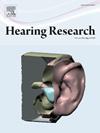形态发生后小鼠内耳中持续的Wnt信号:在毛细胞、支持细胞和螺旋神经节神经元中
IF 2.5
2区 医学
Q1 AUDIOLOGY & SPEECH-LANGUAGE PATHOLOGY
引用次数: 0
摘要
哺乳动物内耳毛细胞的再生能力因耳蜗和前庭系统而异。耳蜗中的毛细胞缺乏再生能力,而前庭系统中的毛细胞则表现出有限的再生潜力。然而,耳蜗内的支持细胞保持增殖能力,使其成为听觉再生研究的重点。类似地,螺旋神经节神经元在出生之前都是活跃增殖的,但在出生后一周内就失去了这种能力,共享毛细胞的再生限制。本研究探讨了典型Wnt信号通路作为这些细胞的潜在调节剂的作用。Wnt信号在耳发育和内耳形态发生中起重要作用。利用报告小鼠,我们分析了从胚胎到成年细胞阶段内耳Wnt典型通路的活性,并评估了荧光强度作为信号活性的指标。我们的研究结果表明,从发育到成年,Wnt信号在前庭毛细胞以及耳蜗和前庭的支持细胞中保持活跃。此外,在出生后7天螺旋神经节神经元中观察到Wnt活性,与它们的增殖潜能期相吻合。这些发现表明,Wnt信号在出生前后的内耳细胞增殖中都是不可或缺的。本文章由计算机程序翻译,如有差异,请以英文原文为准。
Sustained Wnt signaling in the mouse inner ear after morphogenesis: In hair cells, supporting cells, and spiral ganglion neurons
The regenerative capacity of inner ear hair cells in mammals varies between the cochlea and the vestibular system. Hair cells in the cochlea lack regenerative ability, whereas those in the vestibular system exhibit limited regenerative potential. However, supporting cells in the cochlea retain proliferative capacity, making them a key focus in auditory regeneration research. Similarly, spiral ganglion neurons actively proliferate until birth but lose this ability within a week postnatally, sharing the regenerative limitations of hair cells. This study investigated the role of the canonical Wnt signaling pathway as a potential regulator of these cells. Wnt signaling plays a crucial role in otic development and inner ear morphogenesis. Using reporter mice, we analyzed the activity of the Wnt canonical pathway in the inner ear at the cellular stages from embryonic to adult stages, assessing fluorescence intensities as an indicator of signaling activity. Our findings demonstrate that Wnt signaling remains active in the vestibular hair cells and in the supporting cells of both the cochlea and vestibule throughout development and into adulthood. In addition, Wnt activity was observed in spiral ganglion neurons up to 7 days after birth, coinciding with their period of proliferative potential. These findings suggest that Wnt signaling is integral to cell proliferation in the inner ear both before and after birth.
求助全文
通过发布文献求助,成功后即可免费获取论文全文。
去求助
来源期刊

Hearing Research
医学-耳鼻喉科学
CiteScore
5.30
自引率
14.30%
发文量
163
审稿时长
75 days
期刊介绍:
The aim of the journal is to provide a forum for papers concerned with basic peripheral and central auditory mechanisms. Emphasis is on experimental and clinical studies, but theoretical and methodological papers will also be considered. The journal publishes original research papers, review and mini- review articles, rapid communications, method/protocol and perspective articles.
Papers submitted should deal with auditory anatomy, physiology, psychophysics, imaging, modeling and behavioural studies in animals and humans, as well as hearing aids and cochlear implants. Papers dealing with the vestibular system are also considered for publication. Papers on comparative aspects of hearing and on effects of drugs and environmental contaminants on hearing function will also be considered. Clinical papers will be accepted when they contribute to the understanding of normal and pathological hearing functions.
 求助内容:
求助内容: 应助结果提醒方式:
应助结果提醒方式:


